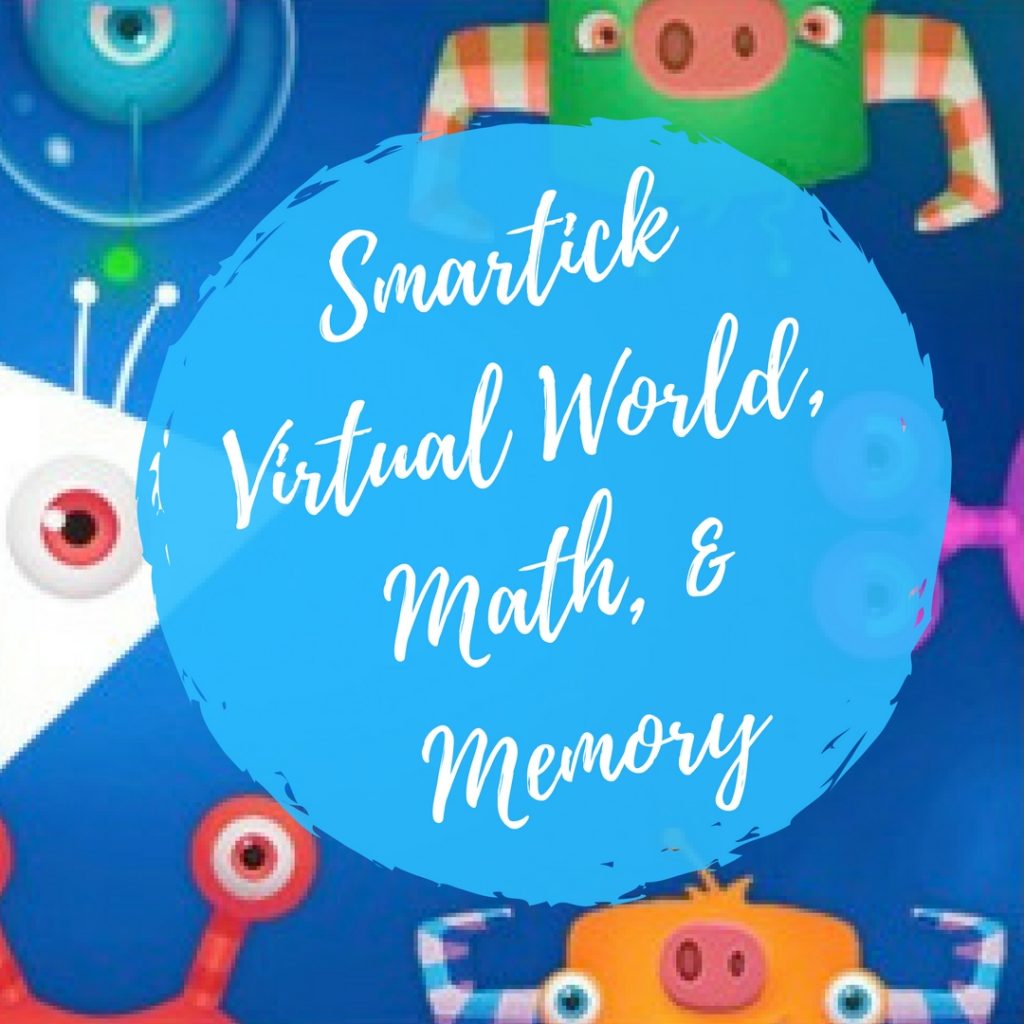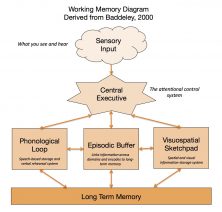
What is Working Memory?
Math skills and achievement are related to a student’s memory, or in technical terms, their mental capacity to encode, store, and retrieve information [1,2]. There are two types of memory relevant to arithmetic operations:
- Long-term memory allows you to remember facts (i.e. your mother’s birthday), general knowledge (i.e. the sounds of letters), personal experiences (i.e. your first day of school), and procedures (i.e. how to ride a bike).
- Working memory is a temporary storage system controlled by our attention. For example, if someone asks you to remember a phone number, it will stay in your working memory as long as you keep your attention focused on it. The second you think about something else, you forget the number.
The creation of a memory starts off in working memory. For example, when we are first learning simple addition, we have to practice it repeatedly and focus our attention on the operation. After we have mastered the operation, it goes into long-term memory and we can do it without consciously thinking about the steps involved. When we perform these simple operations (addition, subtraction, multiplication, or division) or solve more complicated word problems, we rely on our working memory to interpret and later encode the information or procedure.
Based on Baddeley’s theory [3], there are four parts of working memory:
- Central executive: responsible for controlling your attention.
- Phonological loop: responsible for holding speech-based information that you hear.
- Visuospatial sketchpad: responsible for holding visual and spatial information that you see.
- Episodic buffer: responsible for the link to long-term memory and integrating information from all systems into a unified experience [4].
The diagram below helps illustrate the processing of sensory information, which goes through the central executive and subsequent systems of working memory before eventually being encoded in long-term memory. For example, in a simple “2 + 3” addition problem, you look (sensory input) at the 2 and the 3, pay attention (central executive) to the numbers and focus on the necessary arithmetic operation, and process or manipulate the visual information (visuospatial sketchpad) in order to complete the problem. The “2 + 3” operation might then be stored in your long-term memory; in the future, you won’t have to use your mental blackboard for calculations, you’ll just retrieve it from long-term memory.
Why is Working Memory Important for Math?
When it comes to performing math operations, working memory is especially important for manipulating and maintaining information, as well as retrieving it from long-term memory [1]. In particular, the visuospatial sketchpad has been linked to math performance during elementary school because it functions as a mental blackboard supporting number representation, such as place value and alignment in columns, in counting and arithmetic [4,5,6,7]. The central executive also plays a significant roll in directing attention to different aspects of the problem.
To solve a math problem, such as 7 x 12, a child needs to hold the relevant information in their mind and manipulate it. The problem may be solved by using the strategy to split this problem into subproblems [(7 x 10) + (7 x 2) = 70 + 14], requiring the child to keep the answer to one of the subproblems in mind, while also keeping track of the manipulations and intermediate solutions [4]. There is ample evidence that children with a higher working memory capacity have an advantage in mathematics [8,9,10,11]. It is easy to imagine how being able to hold more information in your head would give you an advantage in arithmetic problem solving.
How are Smartick Virtual World Games relevant to Working Memory and Math?
When a student completes tasks in Smartick Method at any level, they are relying on both their working memory and long-term memory. Some of the games in the Smartick Virtual World aim to increase a student’s working memory capacity; playing these brain-training games challenges the student’s current working memory and may have the potential to expand it. Research has shown that brain-training games, similar to memory games (i.e. Crazy Planet) in Smartick Virtual World, can improve working memory [12,13,14].

The correlational relationship between math achievement and working memory, as well as brain training games and working memory, suggests that they might all be connected [12,14]. Playing games in the Smartick Virtual World may have the potential to increase your child’s working memory and, as a result, improve their math achievement in Smartick Method and school [12]. The field of research on these correlational relationships is still growing, but suggests that the brain-training games in the Smartick Virtual World are not only fun for your child, but also potentially valuable to their math skills and school achievement.
At Smartick, we are always looking for the best ways to encourage development and stimulate brain growth. That’s why we plan to present our own research findings on brain-training games in correlation with increased math achievement as part of the Horizon 2020 EU Research and Innovation Program.
References:
- Glossary of Psychological Terms. (n.d.). From Gerrig, Richard J. & Philip G. Zimbardo. Psychology And Life, 16/e. Published by Allyn and Bacon, Boston, MA. Copyright (c) 2002 by Pearson Education. Reprinted by permission of the publisher. Retrieved March 22, 2018, from http://www.apa.org/research/action/glossary.aspx?tab=13.
- Cragg, C., Richardson S., Hubber, P. J., Keeble, S., & Gilmore, C. (2017). When is working memory important for arithmetic? The impact of strategy and age, PLoS ONE 12 (12),
- Baddeley, A. (2000). The episodic buffer: A new component of working memory? Trends in Cognitive Sciences, 4, 417–423.
- Van de Weijer-Bergsma, E., Kroesbergen, E. H., Jolani, S., & Van Luit, J. E. H. (2016). The Monkey game: A computerized verbal working memory task for self-reliant administration in primary school children. Behav Res Methods, 48(2), 756-71.
- D’Amico, A. & Guarnera, M. (2005). Exploring working memory in children with low arithmetical achievement. Learning and Individual Differences 15(3), 189-202.
- Meyer, M. L., Salimpoor, V. N., Wu, S. S., D. C., Geary, & Menon, V. (2010). Differential Contribution of specific working memory components to mathematics achievement in 2nd and 3rd graders. Learning and Individual Differences, 20(2), 101-109.
- McLean, J. F., & Hitch, G. J. (1999). Working memory impairments in children with specific arithmetic learning difficulties. Journal of Experimental Child Psychology, 74, 240–260.
- Friso-van den Bos, I., Van der Ven, S. H. G., Kroesbergen, E. H., & Van Luit, J. E. H. (2013). Working memory and mathematics in primary school children: A meta-analysis. Educational Research Review, 10, 29–44.
- Raghubar, P., Barnes, M. A., & Hecht, S. A. (2010). Working memory and mathematics: A review of developmental, individual difference, and cognitive approaches. Learning and Individual Differences, 20, 110–122.
- De Smedt, B., Janssen, R., Bouwens, K., Verschaffel, L., Boets, B., & Ghesquière, P. (2009). Working memory and individual differences in mathematics achievement: A longitudinal study from first grade to second grade. Journal of Experimental Child Psychology, 103, 186–201.
- Bull, R., Espy, K. A., & Wiebe, S. A. (2008). Short-term memory, working memory, and executive functioning in preschoolers: Longitudinal predictors of mathematical achievement at age 7 years. Developmental Neuropsychology, 33, 205–228.
- Wexler, B. E., Iseli, M., Leon, S., Zaggle, W., Rush, C., Goodman, A., Imal, A. E., & Bo, E. (2016). Cognitive Priming and Cognitive Training: Immediate and Far Transfer to Academic Skills in Children. Nature: Scientific Reports 6(32859), 1-9.
- Brehmer, Y., Westerberg, H., & Bäckman, L. (2012). Working-memory training in younger and older adults: training gains, transfer, and maintenance. Front Hum Neurosci., 6(63), 1-7.
- Nouchi, R., Yasukyuki, T., Takeuchi, H., Hashizume, H., Nozawa, T., Kambara, T., … Kawashima, R. (2013). Brain Training Game Boosts Executive Functions, Working Memory and Processing Speed in the Young Adults: A Randomized Controlled Trial. PLoS ONE, 8 (2), e55518.
Learn More:
- Exploring Cognitive Training Using Memory Games
- Cognitive Flexibility Games with SmartickBrain
- Lost Objects: The New SmartickBrain Game to Train Attention
- Cognitive Training and Its Application to Improve Dyscalculia Symptoms
- Searching for Fun Activities for Your Kids This Summer?







